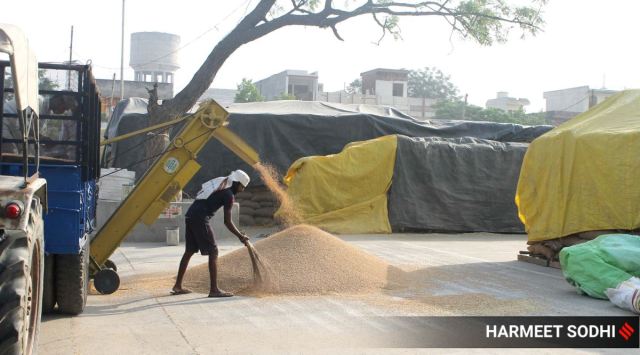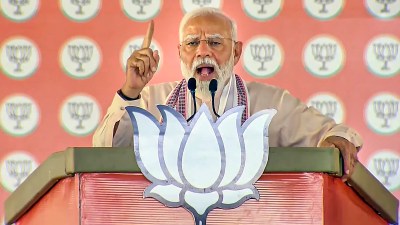- India
- International
Govt bans wheat exports after new low output estimate, says need to ensure food availability
Export of all wheat, including high-protein durum and normal soft bread varieties, have been moved from “free” to the “prohibited” category.
 A labourer cleans and dries wheat at a grain market in Patiala. (Express Photo: Harmeet Sodhi)
A labourer cleans and dries wheat at a grain market in Patiala. (Express Photo: Harmeet Sodhi)A day after announcing that trade delegations were being sent to nine countries “for exploring possibilities of boosting wheat exports from India”, the government Saturday banned all shipments of the cereal with immediate effect.
Export of all wheat, including high-protein durum and normal soft bread varieties, have been moved from “free” to the “prohibited” category.
Only two kinds of shipments will henceforth be allowed: exports based on permission granted by the Centre to other countries “to meet their food security needs” and “on the request of their governments”; and contracted exports against which irrevocable letters of credit have already been issued “on or before the date of this notification, subject to submission of documentary evidence as prescribed,” according to a notification by the Department of Commerce.
The sudden and unexpected export ban comes even as government data, on May 12, showed annual consumer price inflation hitting a near eight-year high of 7.79 per cent in April and retail food inflation surging higher to 8.38 per cent. Putting a check on rising food inflation apart, the decision has apparently been taken in view of procurement of wheat by government agencies plunging to a 15-year-low, with only 18 million tonnes (mt) bought so far in the current marketing season, as against the record 43.3 mt in 2021-22.
While the wheat marketing season technically extends from April to March, the bulk of government procurement at minimum support price (MSP) happens from April to mid-May.
Commerce Secretary B V R Subrahmanyam defended the ban, saying primacy was being given to ensure “adequate food availability in the country”. The government, he said, is committed not only to the food security of India, but also that of “neighbouring and other vulnerable developing countries.”

India’s wheat exports hit an all-time-high of 7.22 mt valued at $2.05 billion in the fiscal ended March 31, 2022.
According to Subrahmanyam, almost half of it went to Bangladesh. “We have kept the window open for our neighbours and also for a large number of vulnerable countries facing genuine scarcity if their governments make a request,” he said.
In mid-February, the Agriculture Ministry had estimated India’s 2021-22 wheat crop (marketed in 2022-23) at a record 111.32 mt. Based on that, it was expected that the country’s wheat shipments would be anywhere from 10 mt to 15 mt this fiscal. On April 15, Commerce and Industry Minister Piyush Goyal had tweeted that Indian farmers “have ensured our granaries overflow & we are ready to serve the world”.
 For the current fiscal, an estimated 4.5 mt of exports have already been contracted, with 1.46 mt being shipped out in April alone.
For the current fiscal, an estimated 4.5 mt of exports have already been contracted, with 1.46 mt being shipped out in April alone.
But these projections did not factor in yield losses from the sudden spike in temperatures from mid-March, which impacted the standing wheat crop when it was in the crucial “dough” stage. This is the time when the wheat kernels accumulate starch, protein and other dry matter, with maximum temperatures ideally in the early 30 degrees Celsius range to permit optimal grain filling and weight gain. With temperatures crossing 35 degrees in mid-March and 40 degrees by the month-end, this resulted in premature ripening and shrivelling of the grains.
Ground reports from most parts of the country – barring Madhya Pradesh where the crop is ready for harvesting by mid-March – suggest wheat farmers harvesting 15-20 per cent less grain compared to last year. The Sunday Express has learnt that the government’s own internal revised estimate of wheat production for 2021-22 is now 98 mt, the lowest since the 92.3 mt of 2015-16.
Agriculture Secretary Manoj Ahuja, however, maintained that the yield losses are not that high and “our estimates of production (as of now) are 105-106 mt”.
For the current fiscal, an estimated 4.5 mt of exports have already been contracted, with 1.46 mt being shipped out in April alone. It’s not clear how much wheat was exported until May 13 or would get covered under the transitional arrangements.
“The ban is an anti-farmer move. If the government was so bothered about inflation, it could have gradually filtered exports rather than resorting to a knee-jerk ban. This could have taken the form of a minimum export price (below which shipments cannot take place) or a tariff,” said Ashok Gulati, a leading agriculture economist.
The export ban may also force farmers, who have held back their crop in anticipation of prices rising in the months ahead, to sell to government agencies at the MSP.
“Government procurement has fallen mainly because farmers are getting higher prices by selling to private traders and exporters. If low procurement and depleting public stocks were a concern, what stopped the government from offering a Rs 200-250 bonus over the MSP (of Rs 2,015 per quintal) to farmers? If you do that even now, farmers will definitely bring more wheat to you. The ban on exports is an implicit tax on farmers,” Gulati said.
Apr 25: Latest News
- 01
- 02
- 03
- 04
- 05









































